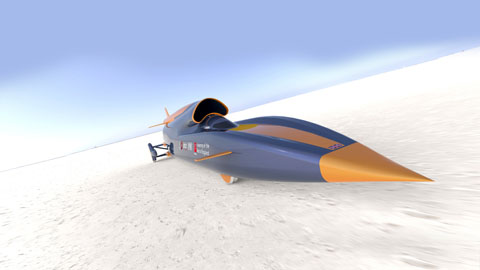What does it take to build a car capable of going 1,000 MPH, 30% faster than any car that has gone before? Richard Noble of Swansea University and lead of the aerodynamics team for the BLOODHOUND SSC (super sonic car) Project, intends to find out by 2011.
When it takes off, BLOODHOUND SSC will be driven by Wing Commander Andy Green, who set the current record of 763mph (1228kmh) at the controls of ThrustSSC on 15th October 1997. If the new vehicle achieves its target of 1,000 MPH (Mach 1.4) it will mark the greatest incremental increase in the history of the World Land Speed Record; it will also exceed the low altitude speed record for aircraft (c.994mph). In context, that means he will be moving four football fields per second.
The aerodynamics team has spent the last year creating the predictive airflow data that has shaped the car. It's academic work now (we don't really need cars that go 1,000 MPH when I can't go over 5 MPH on any street when I visit Taipei, for example) but the research could lead to better vehicle and aircraft design, improved fuel efficiencies, and even new medical techniques.
Medical techniques? Sure. Travelling through a fluid like air at high speed leads to unpredictable pressure events, similar to efforts to anticipate when aneurisms will occur in the human body. Just like it's difficult to work with real hearts, the only way to actually do most of the design work of the BLOODHOUND is numerical modeling.
Bloodhound SSC.
"It's the kind of thing aerospace engineers would have traditionally done in a wind tunnel, but we're doing it on a computer, a big multi-processor super computer. Wind tunnels have massive limitations. BLOODHOUND SSC is a car, so it's rolling on the ground and there are no wind tunnels in existence where you can simulate a rolling ground with a car travelling faster than mach one, faster than the speed of sound," says researcher Dr. Ben Evans, who as a school boy watched the Thrust SSC record on TV.This 'mach factor' is the major difference between this vehicle and its predecessor Thrust SSC. Thrust SSC was a supersonic car in that it crossed the sound barrier and was supersonic for a matter of seconds.
But with BLOODHOUND, the target speed is 1,000mph - mach 1.4. It will be going supersonic way beyond mach one, and for a much longer time period, which means the supersonic shockwaves it creates will be far stronger than Thrust SSC, and they will interact with the car and the desert floor for much longer.
The 12.8m long, 6,422kg (fueled), jet and rocket-powered vehicle will be more advanced than most spacecraft and faster than a bullet fired from a handgun. Its 900mm diameter wheels will spin at over 10,000rpm, generating 50,000 radial g at the rim. The car will accelerate from 0 – 1,050mph in 40 seconds and at V-max (maximum velocity), the pressure of air bearing down on its carbon fibre and titanium bodywork will exceed twelve tons per square meter.

Supersonic aircraft create these shockwaves and they dissipate in the surrounding atmosphere but still reach the ground as a 'sonic boom'.
What the team do know is this 'interaction' creates a phenomenon known as 'spray drag' – a term first coined by BLOODHOUND team member and aerodynamicist Ron Ayers during the Thrust SSC attempts.
"As the car interacts with the desert, and the shockwaves interact with the desert, they actually eat up the desert floor," says Evans.
The Swansea team are also looking at key systems in isolation. Work has already changed the car from twin to single air intake for stability.
"Another thing we have been looking at closely is the exact nose shape. We want a nose that constantly generates a small down force on the front to help keep the car on the ground. But we're also constantly looking a how we can minimise spray drag and if we can constantly achieve a positive pressure on the desert surface leading up to the front wheels then hopefully the surface will remain intact until the front wheels roll over it."

"The whole point of doing this is not just to create a fast car. We live in a carbon economy and lots of the issues we face will require engineers and scientists to solve them – part of this project is to inspire young people."
"Some of my university colleagues are working on blood flow monitoring through the arterial system and trying to predict when aneurysms will explode through pressure loadings.
"There are the obvious applications in aerospace, but any application you can think of that involves fluid flow can be modelled using CFD. Biomechanical systems seems to be one of the areas CFD is being applied to now."




Comments